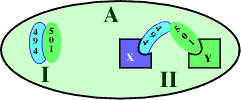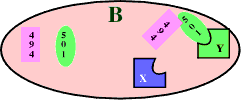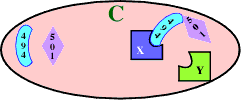|
Modelling the Musketeers: explaining the mutant-suppressor relationships
we observe at position Y494, W501 and G691 (with G740 waiting in the wings
to portray D'Artagnan!). Here, we focus on the 494-501 pairing, modelling
it as a 'lock' that stabilizes the 'Pi-holding' state until external energy
(providing by binding of actin) provides the 'boost' required to 'climb
the mountain'--overcome the energetic barrier between states.
| Explanation |
Structural Model: two states of the motor involving residues
494 and 501 |
Kinetic Interpretation |
| A) In the wild type case, we observe residues
494 and 501 interacting with one another in state I (as is observed
in all extant crystal structures to date). We hypothesize an alternate
state, in which 494 and 501 interact not with each other, but instead
with other components of the motor. |

|

Paired state stability prevents progress through the cycle. Height
of purple arrow indicates energetic barrier to progress
|
| B) Mutating position 494 disrupts the interaction with
residue 501 in state I. However, in state II and the transition state
the 494-X interaction is disrupted, but the 501-Y interaction is not.
Thus overall we postulate that the relative barrier preventing 'forward
progress' is lessened, allowing Pi release in the absence of actin binding. |

|

Breaking up the pairing of 494 and 501 destabilizes the state on
the left, lowering the relative barrier to reaction progress
(purple arrow)
|
| C) Symmetrically, if we instead mutate residue
501, we disrupt state I but only partially harm state II, since the
494-X interaction remains intact. |

|

As above
|
| D) The double mutant restores balance. This arises because
while the 494-501 direct interaction was already in ruins (figures B
and C), whereas the double mutant completes the demise of state II.
Thus balance is restored (admittedly by damaging states I, II and
the reaction intermediate), restoring the local kinetics to a semblance
of normal function. |

|

Further damage to state II and the reaction intermediate restores
the height of the barrier preventing progress from state I (height
of purple arrow)
|
|








